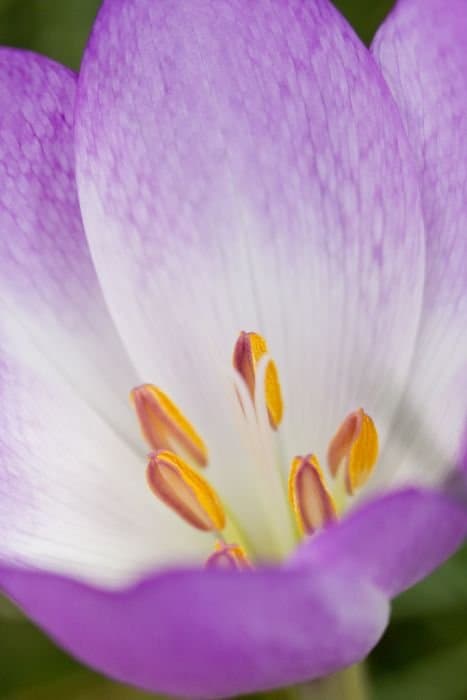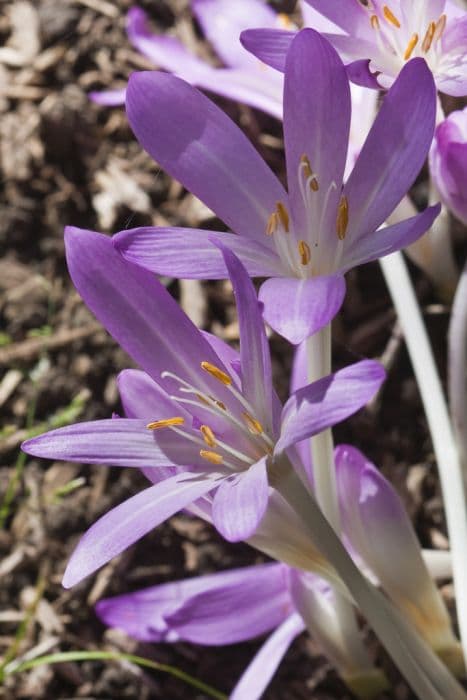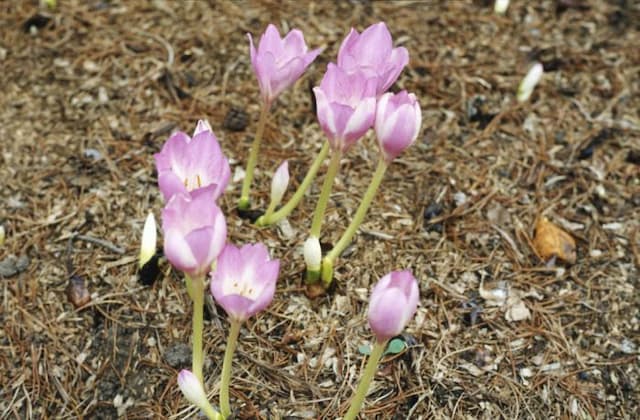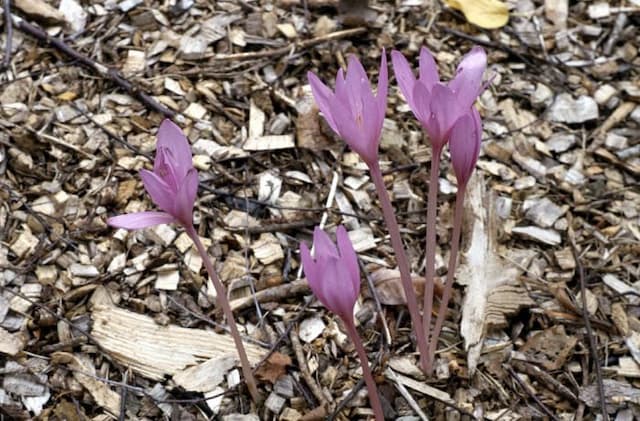Tenore's meadow saffron Colchicum × tenorei

ABOUT
Colchicum × tenorei, commonly known as Tenore's meadow saffron, is a flowering plant known for its striking blooms that resemble crocuses. The flowers emerge in a vibrant range of colors, often displaying various shades of pink or lilac with deep purple veins running through the petals. The petals themselves are elongated, forming a tubular shape that opens into a star-like form at the top with six distinct lobes. The plant's flowers come to life in the absence of visible foliage, as the leaves typically appear after the flowering period, adding an element of surprise to its presentation. The foliage, when it does appear, has a lush, glossy green appearance and in shape is elongated strap-like with smooth edges. As for the fruit, it's concealed beneath the soil, minimizing its visibility in comparison to the showy flowers. The overall impression of Tenore's meadow saffron is one of a delicate, yet striking plant that adds a splash of color to gardens when not much else is in bloom. Its unique life cycle and attractive flowers make it a point of interest for plant enthusiasts and gardeners looking to extend their garden's visual appeal into the cooler months.
About this plant
 Names
NamesFamily
Colchicaceae
Synonyms
Tenore's Meadow Saffron, Hybrid Autumn Crocus
Common names
Colchicum neapolitanum var. lusitanum, Colchicum tenoreanum
 Toxicity
ToxicityTo humans
Autumn Crocus is known to be highly toxic to humans. Ingesting any part of the plant can lead to severe poisoning. Symptoms of Autumn Crocus poisoning can include gastrointestinal distress such as nausea, vomiting, and diarrhea. It can also cause a burning sensation in the mouth and throat, abdominal pain, kidney and liver damage, and blood disorders. In severe cases, ingestion can lead to respiratory failure, multi-organ failure, and can be fatal if left untreated.
To pets
Autumn Crocus is highly toxic to pets. If a pet ingests any part of this plant, it can cause severe symptoms such as vomiting, diarrhea, drooling, abdominal pain, and respiratory difficulties. In severe cases, it can also cause seizures, liver and kidney damage, and bone marrow suppression. Ingestion of Autumn Crocus can be fatal for pets without prompt veterinary treatment.
 Characteristics
CharacteristicsLife cycle
Perennials
Foliage type
Deciduous
Color of leaves
Green
Flower color
Pink
Height
6 inches (15 cm)
Spread
6 inches (15 cm)
Plant type
Bulb
Hardiness zones
4
Native area
Mediterranean
Benefits
 General Benefits
General Benefits- Ornamental Value: Colchicum × tenorei, commonly known as Tenore's autumn crocus, adds aesthetic appeal to gardens with its vibrant, colorful blooms in the fall.
- Drought Tolerance: Once established, Tenore's autumn crocus is known for its ability to withstand periods of drought, making it suitable for water-conservative landscaping.
- Low Maintenance: This plant requires minimal care once it's settled in the landscape, making it a convenient choice for busy gardeners.
- Pest Resistance: Tenore's autumn crocus is generally resistant to pests, reducing the need for chemical treatments.
- Deer and Rabbit Resistant: The plant is not typically favored by deer or rabbits, helping to prevent damage to garden displays.
 Medical Properties
Medical Properties- This plant is not used for medical purposes.
 Air-purifying Qualities
Air-purifying QualitiesThis plant is not specifically known for air purifying qualities.
 Other Uses
Other Uses- Colchicum × tenorei, commonly known as Tenore's Colchicum, can be planted among shrubberies where its autumn blossoms can unexpectedly add color to the fall palette of the garden.
- This plant's corms can be used in botanical studies and education to demonstrate corm structure and plant propagation through corm division.
- With its striking autumnal flowers, Tenore's Colchicum is suitable for cut flower arrangements, bringing unexpected beauty to indoor setups in the latter part of the year.
- The leaves of Tenore's Colchicum provide a rich green backdrop in spring for early flowering bulbs, before going dormant in the summer.
- In landscape design, Tenore's Colchicum can be used to create 'surprise' flowering points when other plants have finished their bloom cycle.
- Gardeners may use the dried seed pods of Tenore's Colchicum for crafting or as part of natural dried flower displays.
- This plant can be used in ecological gardens to support biodiversity, providing a source of nectar for insects in the autumn season.
- Tenore's Colchicum can be placed along edges of woodland gardens, where their hardy nature and low maintenance align well with woodland planting schemes.
- As a naturalizer, Tenore's Colchicum can be allowed to spread in grassy areas, creating a 'meadow-like' appearance when in bloom.
- The plant's ability to bloom in the autumn makes it an excellent candidate for educational purposes, illustrating the diversity of flowering seasons in temperate climates.
Interesting Facts
 Feng Shui
Feng ShuiThe plant Autumn Crocus is not used in Feng Shui practice.
 Zodiac Sign Compitability
Zodiac Sign CompitabilityThe plant Autumn Crocus is not used in astrology practice.
 Plant Symbolism
Plant Symbolism- Renewal - Colchicum × tenorei, also known as Tenore's Meadow Saffron, blooms in autumn, symbolizing the idea of renewal and the cyclical nature of life, as it heralds the changing seasons and the coming of spring after winter.
 Water
WaterThe Autumn Crocus requires watering when the top inch of soil feels dry to the touch, which could be about once a week, depending on environmental conditions. During active growth in the fall, you might need to water every few days, about 16 ounces (0.5 quarts) each time to ensure the soil is evenly moist but not soggy. When the plant is dormant, reduce watering significantly. Always avoid letting the plant sit in water as this can cause bulb rot.
 Light
LightThe Autumn Crocus thrives in partial to full sunlight conditions. The plant will do best in a spot that provides morning sunlight and shade during the intense afternoon heat. Ensuring that the Autumn Crocus gets at least 3 to 4 hours of direct sunlight daily will promote healthy growth and flowering.
 Temperature
TemperatureThe Autumn Crocus prefers a temperate climate with temperatures ranging from 60 to 75 degrees Fahrenheit during its growing season. It can tolerate a minimum temperature of around 50 degrees Fahrenheit and should be protected from temperatures below 40 degrees Fahrenheit to avoid damage. The plant enters dormancy in late spring and can withstand higher temperatures during this period.
 Pruning
PruningPruning the Autumn Crocus is mainly about removing spent flowers and yellowing foliage. It's important to let the leaves die back naturally after flowering to allow the plant to store energy for the next season. Prune in late spring to early summer when foliage has yellowed and withered, which typically happens annually.
 Cleaning
CleaningAs needed
 Soil
SoilAutumn crocus prefers well-drained soil with a mix of loam, sand, and compost to ensure good drainage. The ideal soil pH for Colchicum × tenorei should be neutral to slightly alkaline, around 6.5 to 7.5. Adjusting pH and adding organic matter yearly will improve soil quality for optimal growth.
 Repotting
RepottingAutumn crocus bulbs should be repotted every 3-5 years to refresh the soil. Overcrowding can reduce blooming, so repot when clumps become dense, ideally after foliage dies back.
 Humidity & Misting
Humidity & MistingAutumn crocus is tolerant of a wide range of humidity levels and does not require any special humidity considerations. Normal outdoor humidity is usually sufficient for its growth.
 Suitable locations
Suitable locationsIndoor
Place autumn crocus in bright light and cool temps indoors.
Outdoor
Plant autumn crocus in partial shade and well-drained soil.
Hardiness zone
4-9 USDA
 Life cycle
Life cycleColchicum × tenorei, commonly known as Tenore's autumn crocus, begins its life cycle as a dormant corm deep in the soil. In late summer to early autumn, it emerges and produces vibrant pink to purple flowers without any foliage. Once flowering concludes, the plant enters a period of photosynthesis during the cooler months as leaves appear, absorbing energy and nutrients for the corm. Foliage dies back in late spring as temperatures rise, and the plant enters summer dormancy, reserving energy in the corm. Throughout the season, if conditions are favorable, the corm may produce offsets, thus gradually forming a clump. Each year, the cycle repeats as the corm awakens from dormancy to bloom in the fall.
 Propogation
PropogationPropogation time
Spring
The most popular method of propagation for Colchicum × tenorei, commonly known as Tenore's autumn crocus, is through division of its corms. This should be done in the summer when the plant is dormant, after the foliage has died back. To propagate, carefully lift the entire clump of corms out of the ground using a garden fork, being mindful not to damage them. Then, gently separate the smaller corms from the base of the mother corm. These can be replanted immediately at a depth of about 3 inches (approximately 7.6 centimeters) and spaced around 6 inches apart (about 15.2 centimeters), in well-draining soil with a good exposure to sunlight. Water the newly planted corms lightly to settle the soil around them, and they should grow and flower in the following season.









